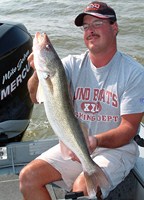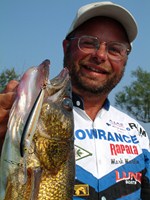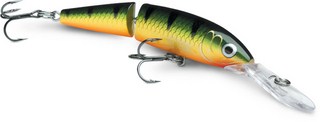Walleyes, Cranks and the Core River Mouth Connection
Category: npaa
Feb 13th, 2012 by OutdoorsFIRST
Modified Feb 13th, 2012 at 12:00 AM
They’re fish stereotyped for ever marauding. But it’s now early spring and Great Lakes and other big water and reservoir walleyes, instead, are gathered together in tight-knit schools in preparation of procreation, which makes the chore of figuring out their whereabouts within these giant waterways easier now than ever. Although there are several places they may migrate to, drowned river mouths are the perfect place for anglers to search out these classically nomadic fish.
It’s all due to the fact that when the moon rises full as water reaches the 40-dergree mark, these long-range roamers will run rivers with nothing but thoughts of proliferation in their pea-sized brains. In the weeks before the hanky-panky initiates, however, the walleyes swim in, out and around where the water flows into these immense lakes, and they feast to fatten on the baitfish that are also collecting here before their own rite of species continuation.
Overall, covering as much water as one can while trolling crankbaits in combination with leadcore line is the perfect plan to fool these fickle fish into believing your lure’s the real deal.
The Melding of Great (Lakes) Minds
Enter two walleye pros who reside near the shoreline of Lake Michigan-literally right across the watery expanse from each other: Mike Gofron of Antioch, Illinois, and Mark Martin from Twin Lakes, Michigan. Both are gurus of all things walleye-related. Along the way, these walleye tournament statesmen have made full-time work out of learning the wily ways of walleyes – and catching them. And both have come to realize that trolling cranks’ in conjunction with leadcore is an unsurpassed way to address the pre-spawn period when fishing wide swaths of water.
First is Gofron, who pulls Rapala crankbaits that best match the forage at hand. He concentrates on pulling those lures along edges, like breaklines and dirty-to-clear-water transitions. And, he does so at faster than average speeds.
 |
|
|
Renowned walleye chaser Mike Gofron rips along in his Lund at 2 to 3 MPH while pulling Rapala crankbaits and leadcore for spring walleyes. Faster than “normal,” Gofron says the line bows slightly, lifting the lure overhead of the fish. Photo courtesy of Lund Boats (www.lundboats.com)
|
“If shad are present, I’ll tie on a #5 or 7 Rapala Shad Rap as they have the same wide-body profile as the forage, while if smelt or shiners are down there, I’ll instead go with the long and slender shape of a #10 or 12 Down Deep Husky Jerk,” says the Rapala pro-staffer. “I also pay special attention to the position of my Lund, making sure to motor in a manner that my lures run right along the breakline or mudline.”
While the norm is to troll at slow speeds with leadcore (1- to 1.8-MPH), Gofron, instead, rips his sticks from 2- to 3-MPH. “Trolling fast with leadcore is not the standard because the heavy diameter of the line pushes a lot of water, and when trolling in deep water-where leadcore’s most often employed -the water resistance pushes the line upward and the lure follows. But this time of year, walleyes are usually in depths under 30-feet out in front of the river mouths, so the rising effect is a positive,” he claims.
As for Martin, he pushes the shallow water leadcore limits by trolling upstream at a creep, in as little as 4-feet if the water’s stained, while running his Lund directly over breaks in the current that he spies with the naked eye. “When the water’s on the rise I’ll troll close to shore as walleyes tend to head there in search of baitfish taking shelter in the overhanging grass and logs. On the other hand, if the water level’s dropping, I’ll concentrate on the current creases in the middle of the river as fish fear getting trapped in the shallows,” he says.
Overall, Martin follows the same rule as Gofron, matching his Rapala’s shape to the baitfish in the system. But sometimes, he finds that jointed body-baits, like Rapala’s new Jointed Deep Husky Jerk, with its wider wiggle, is effective for slowly plowing, actually inching upstream.
 |
|
|
Walleye statesman Mark Martin is a proponent of inching long-bodied, Rapala crankbaits upstream river mouths. The slow, methodical approach requires exceptional patience. But know that big fish happen for those who wait. Photo courtesy of Rapala (www.rapala.com)
|
No matter the depths, though, whether pulling crankbaits with leadcore through lakes or up rivers, both Gofron and Martin let out just enough line so their lures only occasionally tap bottom. “And the occasional ticking of bottom not only lets me know the lure’s in the zone, but it attracts attention to it without over doing it and spooking fish,” says Martin.
Both agree that 18-pound Sufix leadcore is perfect, as it’s the lightest pound test with the maximum amount of lead running through its core. Each tie in 10-pound test Sufix monofilament as a shock leader as well; its length equaling the measurement of the rod itself.
Reach Out and Touch an ‘Eye
Although trolling crankbaits behind leadcore line is about as basic a technique as one could employ (let out line, move boat forward), not just any old rod and reel will do.
When trolling walleyes in shallow, clear water it’s imperative to reach out as far as possible to prevent scattering fish. In-line planer boards are often used, thus a rod that has a moderate action- with a little oomph in the midsection-is necessary to pull a board, yet needs a tip light enough to see every wiggle of the bait. St. Croix’s Eyecon Trolling Rods do just that. Two particular models of Eyecon Trolling Rods have leadcore lineage – a 5-footer just right for pulling cranks directly behind the boat, and a reach-out-and-touch-an-‘eye 12-footer ideal for getting the lure out and away from the boat.
Leadcore Lowdown
Overall, locating big water walleyes and catching them in the early spring is quite simple. Just head towards surging river mouths, where fish will soon spawn, and cover as much water as possible while trolling crankbaits behind leadcore; use equipment built for the task; match your lure’s shape to the forage at hand; and either troll fast in open water, or, at a creep up river.
 |
|
|
Rapala’s new Jointed Deep Husky Jerk produces that irresistible wounded-minnow wobble that Martin and his walleyes demand, while running ideally at 4- to 6-feet of flowing river water. Photo courtesy of Rapala (www.rapala.com)
|
By Mitch Eagan–Mitch Eagan is an outdoor writer and photographer who calls the heart of Michigan’s Upper Peninsula home.